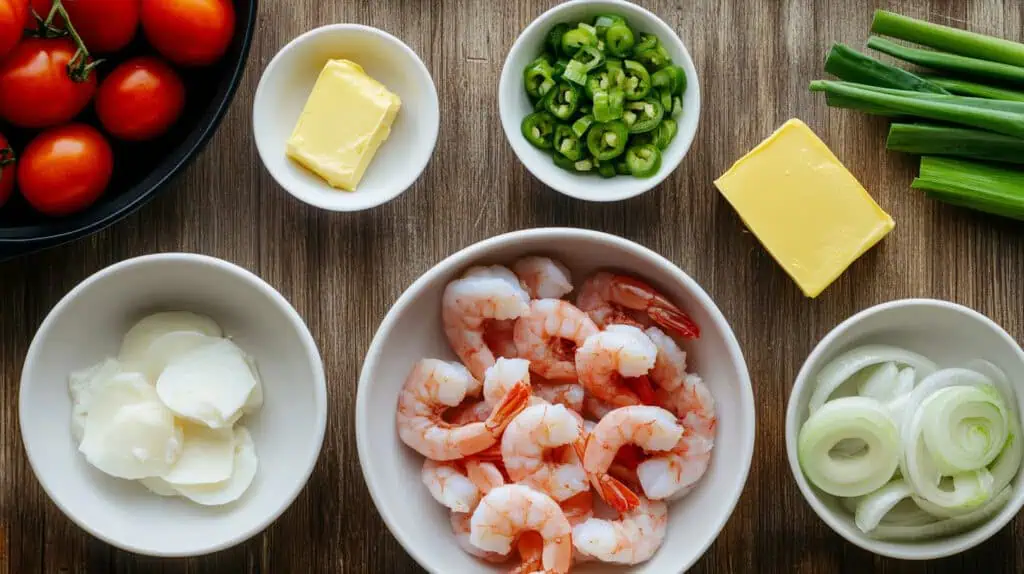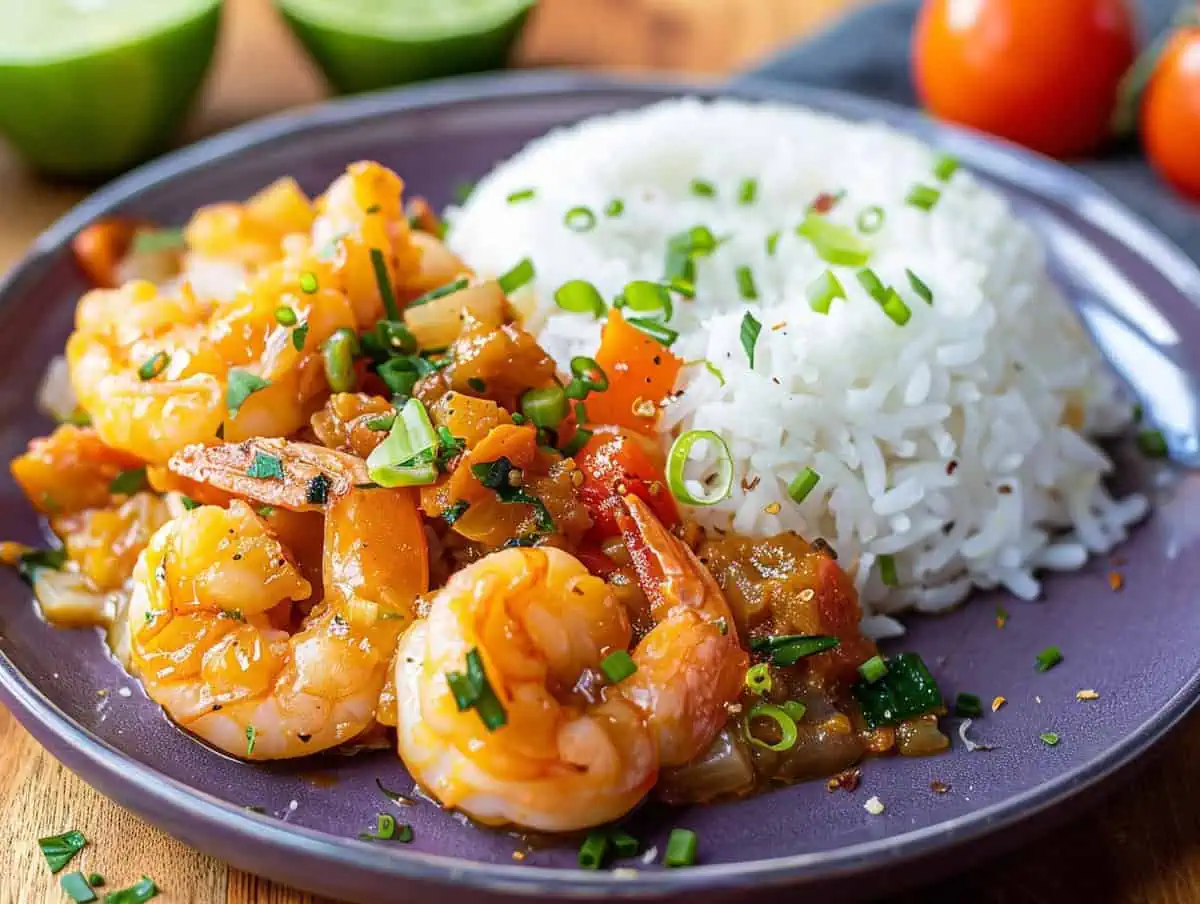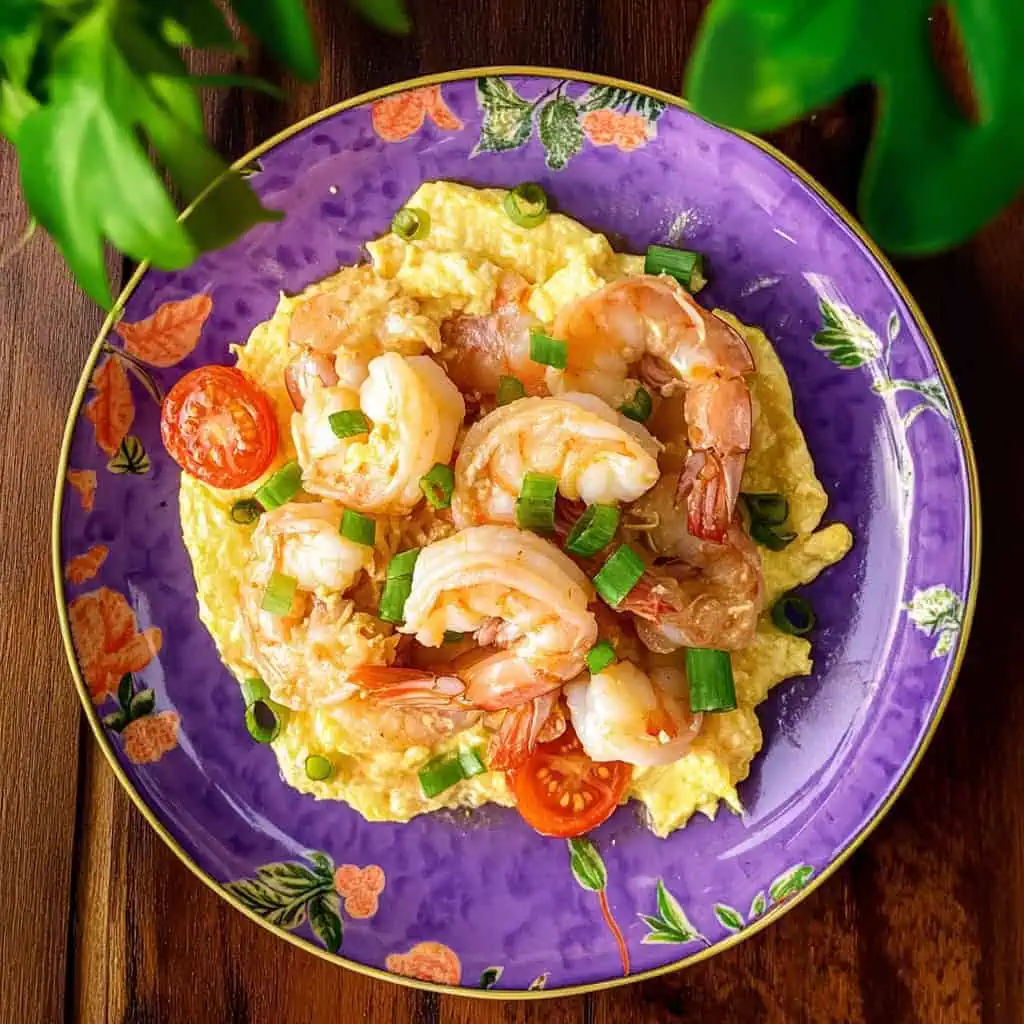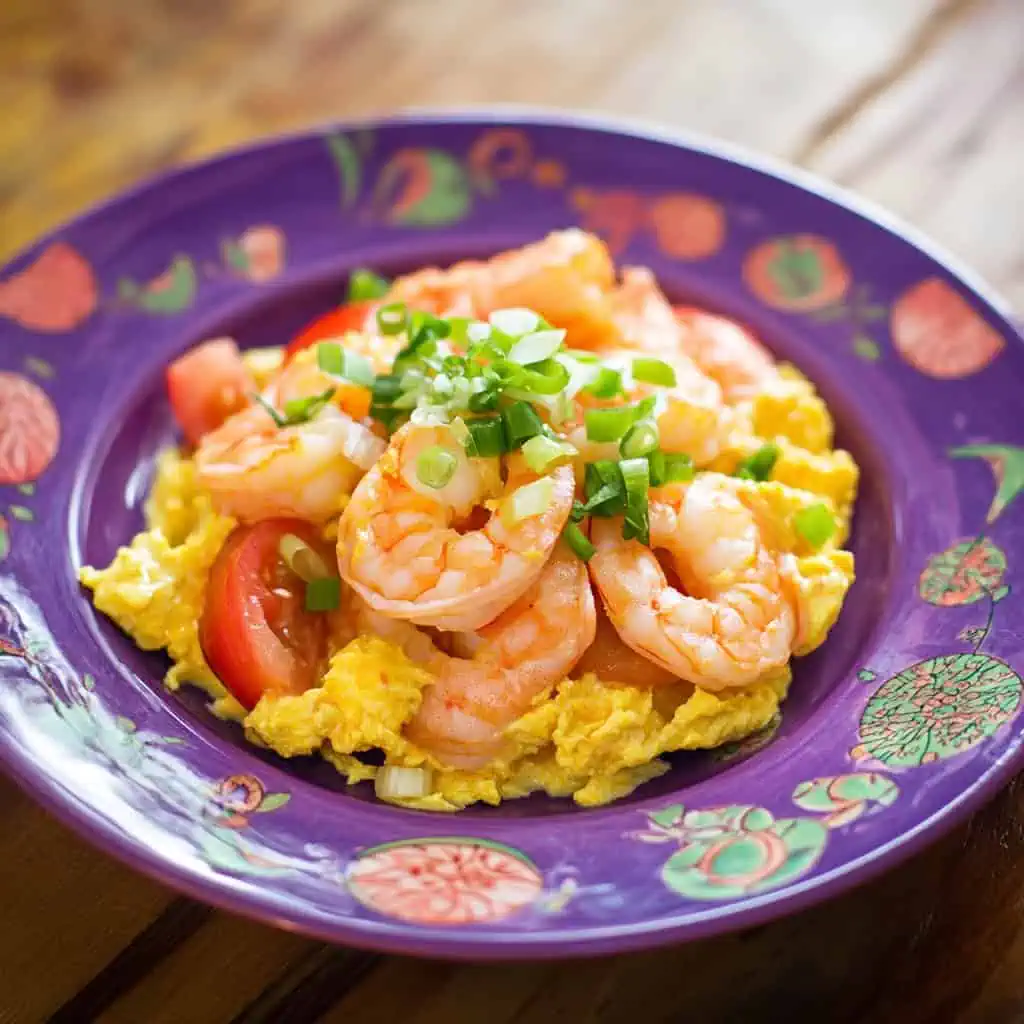Let me share my favorite way to make Shrimp Sarciado. When I was growing up, the smell of butter, tomatoes and shrimp cooking in my Lola's kitchen would get everyone out of bed, excited for breakfast. This simple dish of shrimp and eggs might seem basic. But when the shrimp is perfectly cooked and the eggs are just right, it becomes something truly special.
The best part? You can make it in just 25 minutes with ingredients you probably already have in your kitchen. Whether you're missing Filipino home cooking or just looking for a quick, tasty meal to serve with rice, this recipe never disappoints.
Jump to:

Why You'll Love This Recipe
- Ready in under 30 minutes
- Uses simple, everyday ingredients
- Perfect for busy weekday meals
- Protein-rich and nutritious
- Authentically Filipino
- Customizable with various seafood options
- Kid-friendly dish
Ingredients
This recipe combines ingredients that create the perfect flavor balance in Filipino cuisine. Fresh shrimp provides natural sweetness and protein, while keeping the shells on adds depth of flavor. Butter creates richness and helps develop a golden color on the eggs.
Tomatoes and onions form the aromatic base, adding sweetness and moisture. The eggs bind everything together while making the dish more filling. Green onions add a fresh, mild flavor and vibrant color contrast.
These simple ingredients work harmoniously - the sweetness of shrimp complementing the savory eggs, the acidity of tomatoes balancing the richness of butter, creating a satisfying meal with minimal effort.

- 6-8 large eggs, beaten
- ¼ cup butter
- 2 medium tomatoes, halved and thinly sliced
- 1½ medium onions, thinly sliced
- ½ pound shrimp, cleaned, deveined, shell-on
- Pinch of salt
- 2 tablespoons green onions, chopped for garnish
Equipment
- Large non-stick pan (Kawali) - Ensures eggs don't stick and makes cleanup easier
- Sharp knife - For precise vegetable cutting
- Cutting board - For preparation work
- Measuring cups and spoons - For accurate measurements
- Wooden spoon - For gentle stirring without scratching the pan
- Small bowls - For ingredient organization

How To Make
- Heat your non-stick pan over medium heat (350°F/180°C). While the pan is heating up, make sure your shrimp is cleaned and deveined but keep the shells on for extra flavor.
- Add the butter and let it melt completely without browning. Once melted, add your thinly sliced onions and tomatoes to the pan. Let them cook together for 2-3 minutes until they become fragrant and the tomatoes start to soften.
- Now add your shrimp to the pan and sprinkle a pinch of salt over them. Let the shrimp cook for just 1-2 minutes until they turn a pretty pink-orange color. Remember not to cook them for more than 3 minutes total - overcooked shrimp become tough and rubbery.
- Pour your beaten eggs evenly over the shrimp. Using a wooden spoon, gently stir the eggs through the shrimp mixture, creating soft, fluffy curds. This should take about 1-2 minutes. You want the eggs to be just set but still slightly wet since they'll continue cooking from the residual heat.
- As soon as the eggs are set, turn off the heat and transfer everything to your serving plate. Sprinkle the chopped green onions over the top. Serve immediately while hot, ideally with steaming white rice and some calamansi on the side if you have it.

Tips from Lola's Kitchen
- Fresh is best: Always use fresh shrimp rather than frozen for the most authentic flavor.
- Shell secret: Keeping the shells on adds incredible flavor to the dish. They also help prevent the shrimp from overcooking too quickly.
- Perfect timing: Watch your shrimp carefully - they're done when they form a loose "C" shape and turn pink. An overcooked "O" shape means they'll be tough and rubbery.
- Egg technique: Beat your eggs thoroughly but not excessively to maintain fluffiness. Add them when the shrimp are almost done to prevent overcooking.
- Temperature control: Keep your heat at medium - too high will cook the eggs too quickly, too low won't give you the proper texture.
- Prep matters: Having all ingredients ready before you start cooking ensures nothing overcooks while you're preparing other items.
Traditional Serving Suggestions
This dish is traditionally served with steaming white rice, which soaks up all the delicious flavors. For an authentic Filipino breakfast experience, pair it with garlic rice (sinangag) and have some calamansi or Filipino vinegar (suka) on the side for added brightness.
Substitutions
- Butter: Can be replaced with olive oil or coconut oil for a different flavor profile
- Fresh tomatoes: Canned diced tomatoes (well-drained) will work in a pinch
- Green onions: Substitute with fresh parsley or cilantro for garnish
- Shell-on shrimp: If using peeled shrimp, reduce cooking time by 30 seconds to prevent overcooking
Troubleshooting
- Watery dish: Drain excess liquid from tomatoes before cooking or cook them a bit longer before adding shrimp
- Rubbery shrimp: Reduce cooking time; remove from heat as soon as they turn pink
- Dry eggs: Cook eggs on lower heat and remove while slightly wet as they'll continue cooking
- Too salty: Balance with a squeeze of calamansi juice or a small amount of sugar
- Flavor seems flat: A tiny splash of fish sauce can enhance the seafood flavor without making it fishy
Storage & Reheating
- Store in an airtight container in the refrigerator for up to 2 days
- Reheat gently in microwave for 30-45 seconds or in a covered pan on low heat
- Add a small pat of butter when reheating to restore moisture
- For best results, consume immediately after cooking
- Not recommended for freezing as the texture of both eggs and shrimp will deteriorate

FAQ
Why keep the shrimp shells on?
The shells add more flavor to the dish and help prevent the shrimp from overcooking. They also contain nutrients that enrich the dish.
Can I make this ahead of time?
This dish is best served fresh, but can be stored for up to 2 days in the refrigerator. The texture will change slightly upon reheating.
Is this dish spicy?
No, traditional Shrimp Sarciado is not spicy, but you can add chilies to make it spicy according to your preference.
Can I use other seafood?
Yes, this recipe works wonderfully with fish, squid, or mixed seafood. Adjust cooking times based on the seafood you choose.
How do I know when the shrimp are perfectly cooked?
Perfectly cooked shrimp turn pink-orange and form a loose "C" shape. If they curl into a tight "O" shape, they're overcooked.
Can I use pre-cooked shrimp?
It's not recommended as they'll become tough. If you must use pre-cooked shrimp, add them at the very end just to warm through.
What makes this dish authentically Filipino?
The combination of seafood with eggs is a common Filipino cooking technique, and the simple seasonings allow the natural flavors to shine.
Can I add cheese to this dish?
While not traditional, a sprinkle of mild cheese like queso de bola or kesong puti can add a creamy dimension to the dish.
Related
Looking for other recipes like this? Try these:

Shrimp Sarciado (Sarsiyadong Hipon)
Equipment
- Large non-stick pan (Kawali) ensures eggs don't stick and makes cleanup easier
- Sharp knife (kutsilyo) for precise vegetable cutting
- Cutting board (Sangkalan) for preparation work
- Measuring cups and spoons for accurate measurements
- Wooden Spoon (Sandok Kahoy) gentle stirring without scratching the pan
- Small bowls (mangkok) for ingredient organization
Ingredients
- 6-8 large eggs itlog, beaten
- ¼ cup butter mantikilya
- 2 medium tomatoes kamatis, halved and thinly sliced
- 1½ medium onions sibuyas, thinly sliced
- ½ pound shrimp hipon, cleaned, deveined, shell-on
- Pinch salt asin
- 2 tablespoons green onions dahon ng sibuyas, chopped for garnish
Instructions
- Heat your non-stick pan over medium heat (350°F/180°C). While the pan is heating up, make sure your shrimp is cleaned and deveined but keep the shells on for extra flavor. Add the butter and let it melt completely without browning. Once melted, add your thinly sliced onions and tomatoes to the pan. Let them cook together for 2-3 minutes until they become fragrant and the tomatoes start to soften.
- Now add your shrimp to the pan and sprinkle a pinch of salt over them. Let the shrimp cook for just 1-2 minutes until they turn a pretty pink-orange color. Remember not to cook them for more than 3 minutes total - overcooked shrimp become tough and rubbery.
- Pour your beaten eggs evenly over the shrimp. Using a wooden spoon, gently stir the eggs through the shrimp mixture, creating soft, fluffy curds. This should take about 1-2 minutes. You want the eggs to be just set but still slightly wet since they'll continue cooking from the residual heat.
- As soon as the eggs are set, turn off the heat and transfer everything to your serving plate. Sprinkle the chopped green onions over the top. Serve immediately while hot, ideally with steaming white rice and some calamansi on the side if you have it.
- This whole process should take no more than 10 minutes of cooking time. If you're new to cooking, remember that the key to perfect Sarciado is not overcooking either the shrimp or the eggs - keep an eye on your timing and you'll have a delicious meal ready in no time.
Tips from Lola's Kitchen
- Use fresh, not frozen shrimp for best results
- Keep shells on for more flavor, but remove if preferred
- Don't overcook the shrimp - they should be just pink and curved into a loose "C" shape
- Beat eggs thoroughly but don't overbeat to maintain fluffiness
- Add eggs when shrimp is almost done to prevent overcooking
Nutrition
The Story Behind Shrimp Sarciado
Shrimp Sarciado, known locally as Sarsiyadong Hipon, is a beloved comfort food that showcases the Filipino talent for creating flavorful dishes from simple ingredients. This breakfast favorite emerged from the coastal regions of the Philippines, where fresh seafood has always been a staple of daily meals.
The word "sarciado" (also spelled "sarsyado" or "sarsiado") comes from the Spanish word "zarciado," meaning to sauce or to coat. This cooking style became popular in Filipino households because it transformed basic proteins into satisfying meals by combining them with eggs and a light tomato-based sauce. While fish sarciado might be more common, the shrimp version has become equally treasured, especially in regions where fresh shrimp is abundant.
What makes Shrimp Sarciado particularly special is its role in Filipino breakfast culture. Unlike Western breakfasts that often lean sweet, Filipino households embrace savory dishes that provide energy for the day ahead. This protein-rich combination of shrimp and eggs, when served with garlic rice, creates the kind of hearty breakfast that Filipino families love to wake up to.
In modern Filipino homes, Sarsiyadong Hipon has evolved from being just a breakfast dish to an any-time meal. Working parents appreciate its quick cooking time, while children love the mild, comforting flavors. The dish perfectly represents the Filipino cooking philosophy of "simple but satisfying" - using just a handful of fresh ingredients to create something truly delicious.
Today, you'll find Shrimp Sarciado not only in home kitchens but also in carinderias (local eateries) and even upscale Filipino restaurants. Each family has their own version - some add more tomatoes for a saucier dish, others prefer it drier with more eggs. Some coastal regions even add a splash of fish sauce or calamansi juice to enhance the seafood flavors. This adaptability is perhaps why Sarsiyadong Hipon has remained a Filipino favorite through generations.










Comments
No Comments